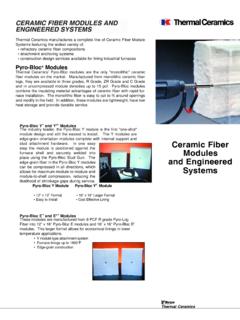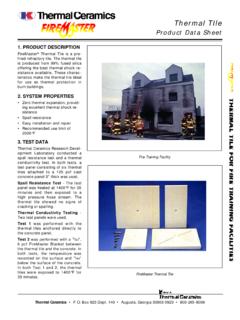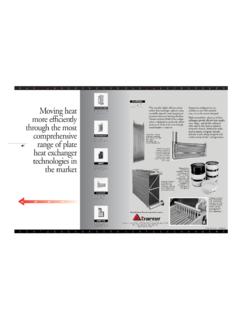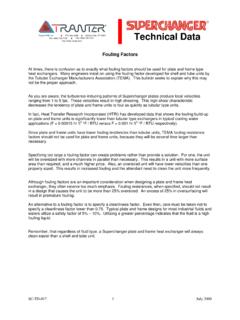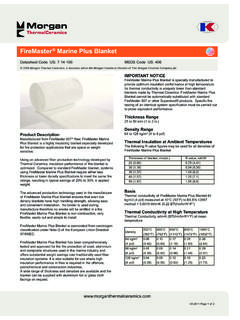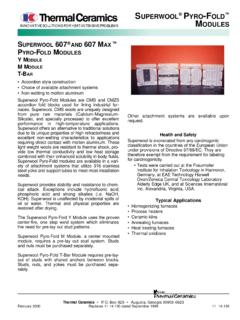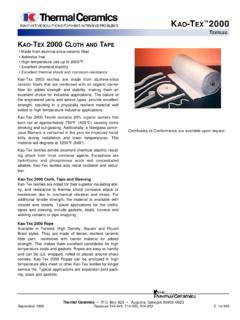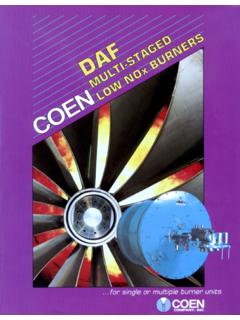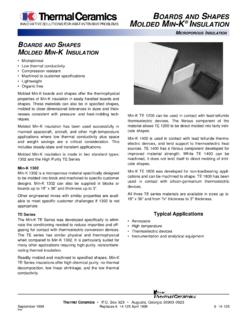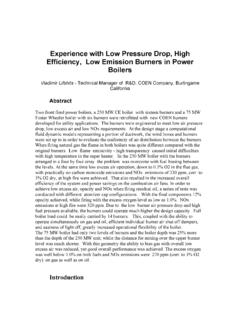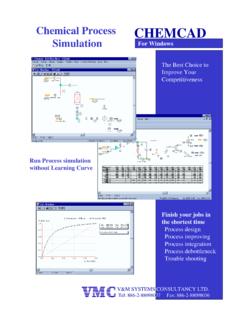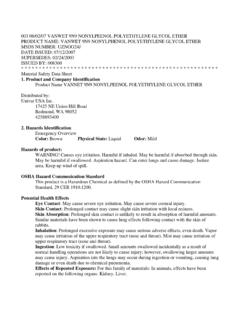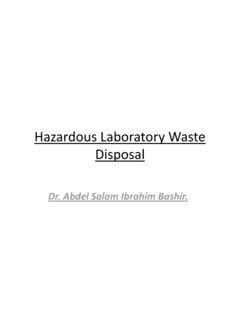Transcription of IN THE AUTOMOTIVE INDUSTRY - Inproheat
1 IN THE AUTOMOTIVE INDUSTRY PRIME SURFACEHEAT EXCHANGERSPLATE & FRAMEHEAT EXCHANGERSALL-WELDED PLATEHEAT EXCHANGERS HEATsEXCHANGERSBULLETIN NO. TIS-107 AHEATsEXCHANGERS THE heat transfer peopleTRANTER BRINGS EFFICIENCY AND RELIABILITY TO THE AUTOMOTIVE INDUSTRYNOTE: THE DIAGRAMS SHOWN ARE PURPOSELY BRIEF: NO ATTEMPT HAS BEEN MADE TOSHOW ALL THE VALVES, PUMPS, CONTROLS, ETC., THAT MAY BE REQUIRED. IN MOST SYSTEMS,ALL PIPING ACTUALLY IS FROM THE SUPERCHANGER FIXED FRAME. THIS FACILITATESOPENING THE UNITS, WHEN REQUIRED, WITHOUT DISASSEMBLING plate and frame units are the best choicebecause they give you: (1) higher U values typically 3 to5 times greater than shell-and-tube; (2) a unique turbulentflow design resulting in lower fouling; (3) closer temperatureapproach capability of less than 2 F, compared to the typi-cal 10 F or higher with shell-and-tube; (4) space savingsof 50% to 90% over shell-and-tube.
2 (5) expandability andeasy servicing, and (6) immediate availability, since they are made in the ALL-WELDEDPLATE HEAT EXCHANGERSW here space is at a premium, or gasket limitations prevent the use of a SUPERCHANGER unit, the compactall-welded MAXCHANGER unit may be the best solutionto many AUTOMOTIVE PRIME SURFACE HEATEXCHANGERSA multitude of design configurations and over 300 differentsizes make PLATECOIL units ideally suited for a variety ofapplications in the AUTOMOTIVE INDUSTRY . They offer versatility in providing the heating and/or cooling required for various applications in the units are perhaps best known as immersion-type, in-tank or as clamp-on heaters for maintaining producttemperatures in tanks.
3 Their use goes far beyond theseapplications, however, and includes designs for custom-engineered processing units can be fabricated from most weldablemetals including carbon steel, stainless steel, titanium,Monel, nickel and various special corrosion-resistantalloys. Surface finishes are available in great variety to minimize fouling and reduce PLATE & FRAMEHEAT EXCHANGERSP late and frame heat exchangers provide a more efficientand cost effective means of heat transfer than old, tradition-al shell-and-tube exchangers. This is particularly true inthe AUTOMOTIVE efficiency and heat are critical needs today inthe AUTOMOTIVE INDUSTRY . Tranter provides these benefitsand more, with PLATECOIL, SUPERCHANGER and MAX-CHANGER heat exchangers that are standards for the Or Dip Washerand/Or PhosphatizingMachineSUPERCHANGERB oiler OrHot WaterGeneratorPlatingSolutionsHEATING METAL FINISHING SOLUTIONST here are hundreds of spray and dip type metalcleaning washers and phosphatizing machines in the AUTOMOTIVE INDUSTRY .
4 In recent years the use ofSUPERCHANGER plate and frame heat exchangershas become very common for heating the varioussolutions. Hot water is generally used for the phosphatizingsolutions to reduce scaling, while steam is most common for the other caustic cleaner, rinse, etc. AND COOLING PLATING BATHSP lating baths may require heating for start up and,generally, cooling during operation. SUPERCHANGER units are widely used, especially for cooling. Thebaths are operated in the 90 F range, and towerwater temperature can be low enough in most locationsto accomplish the cooling. The very efficient SUPERCHANGER heat exchangers act as isolatorsbetween the tower water and the closed circuit cooling MachinesAnd/Or RoboticWelders, ,Pond,River, WELDING MACHINESV arious types of welding machines require include resistance seam welders, automaticspot and robotic machines.
5 There are large installationsin the INDUSTRY which use SUPERCHANGER units for cooling many machines. Here again, tower watertemperatures are low enough for cooling the cleanloop water which is circulated through the SUPERCHANGER units isolate the two water AUTOMOTIVE INDUSTRY AND HEATING ANODIZING SYSTEM SOLUTIONSThe close temperature approach capability ofSUPERCHANGER units makes them ideal for coolingconventional anodizing solutions which need to bemaintained at about 72 F. Hard coat baths operate ata much lower temperature, requiring a refrigerationsystem. Many of the units are used to isolate the dirtytower water from the closedloop water which coolsthe condenser water from the refrigeration unit, orcools anodizing solutions dip, hot sealtanks, etc.
6 In the anodizing systems are often heatedwith steam by using TankPond Or CoolingTower, QUENCH OILSSUPERCHANGER plate and frame heatexchangers are designed for efficient perfor-mance in quench oil to cooling water duty bythe use of mixed plates. This capability tendsto equalize the varying oil side and water sidetransfer rates so that optimum overall heattransfer rates are obtained. Typically the oil ispumped through the exchanger to be cooledby tower or pond water, And GrindingMachinesSUPERCHANGERC oolingTower, Soluble Oil CoolantBoilerSUPERCHANGERBlow Down To DrainBoilerMake-UpWaterHEAT RECOVERYThe typical waste liquid-to-water heat recoveryinstallation utilizing SUPERCHANGER plate andframe heat exchangers will pay back in one totwo years, often quicker.
7 Almost any warm orhot waste steam can be used. Condensate fromboiler blow down for preheating boiler feed wateris a common application. Hot waste streamsalso often must be cooled before they can bedischarged. This makes heat recovery a logical OrHeat GeneratorPLATECOIL UnitSmall PartsWasher85 COOLING MACHINING ANDGRINDING COOLANTSSome plants have installed SUPERCHANGER units at various central locations throughoutmetal machining and grinding areas. The coolantsare piped to each central station and circulatedthrough SUPERCHANGER exchangers forcooling with tower, pond or river water, etc. The very small amount of space required andthe excellent heat transfer efficiency were primereasons these plants converted from shell-and-tube exchangers to SUPERCHANGER OR COOLING METALFINISHING SOLUTIONSPLATECOIL prime surface heat exchangershave been used for over 50 years for heatingand cooling a variety of metal finishing units can be immersed, clamped on, or builtinto solution tanks.
8 A unique chimney effect iscreated by placing the PLATECOIL units awayslightly from the tank side, which provides moreprecise and even heating of solutions, withoutthe dilution or wastefulness of steam sparging or submerged combustion AUTOMOTIVE INSTALLATIONFOR SUPERCHANGER EXCHANGERSSUPERCHANGER CONDENSED SPECIFICATIONS5 These large SUPERCHANGER plate and frame heatexchangers cool closed loop water, which is used tocool automatic welding machines, for a major manufacturer at its Maryland plant. Theunits have provided the company significant cost-efficiency in heat transfer since their units are employed in a number ofmajor applications in the AUTOMOTIVE INDUSTRY . Chiefamong these are: heating wash, phosphate and rinsesolutions; temperature control of paint or plating solu-tions; waste liquid-to-water heat recovery; and efficientperformance in quench oil to cooling water duty, bythe use of mixed plates, among other data on this page provides basic condensed engi-neering information.
9 All selections are calculated bycomputer to provide the best plate size and design fitfor each specific application. More complete literatureand specifications are available on Rating:Up to 400 psig operating pressureMaximum Temperature:366 FHeat Transfer Coefficients:Greater than 1000 Btu/hr ft2 FHeat Transfer Surface:Up to 20,000 ft2per unitPlates:SUPERCHANGER plates are fabricated fromvirtually any metal that can be cold-worked, includingstainless steel (types 304, 316, 317, etc.), titanium,Monel, nickel, alloys 825, 20Cb-3, B-2, G, C-276 and :Carbon steel with baked epoxy enamelpaint, side bolts and :150 lb. rated flange type, with other options :Nitrile, Ethylene Propylene, Viton,Neoprene, Hypalon, Butyl, Teflon-encapsulated NBRand others Extras:Connecting frames.
10 Threaded orclamp type nozzles. Stainless steel tightening Code Units Available:SUPERCHANGER units are available on a trial basis for in-plant testing andevaluation. Contact your Tranter representative forinformation on the SUPERCHANGER Trial Unit DesignSUPERCHANGER OUTPERFORMS SHELL-AND-TUBE6 SUPERCHANGER heat exchangers require much lessspace than shell-and-tube units. They can pack greaterthan 20,000 sq. ft. of super efficient heat transfer surface in a single unit with flow rates up to 25,400 gpm. Theyprovide greater flexibility; are more easily cleaned; experience much less fouling; have no interleakage; are lighter in weight; and cost importantly, however, SUPERCHANGER units do amore efficient job of transferring heat in most applications,due in large measure to the turbulent flow created by thecorrugated patterns of their a side-by-side comparison between SUPERCHANGER plate and frame heat exchangers and shell-and-tubeexchangers, the charts below show the difference indimensions and comparative performance data for twounits in an identical application.
